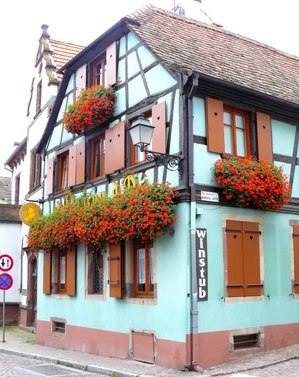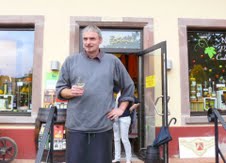COLMAR, France--Whenever one of the wine mags wants a cover shot of vineyards at the foot of a medieval castle, or grapevines clustered around an old stone church, they go for Alsace: it's the most picturesque wine region in France. Alsace, Burgundy and Champagne long ago teamed up for a joint promotional campaign, the ABCs of France; Alsace wines go it alone on this site, and Alsace Tourism is here, and yet another that focuses on the affinity of Alsatian wine and food.
The Frenh government's tourism development agency, which keeps track of these things, tells us that Alsace is the third most-popular wine region in France, with nearly 1.5 million cellar visits a year (behind Bordeaux, with 3.6 million and Burgundy with 2.5 million). Not necessarily a fair comparison: Bordeaux has 10,000 properties and covers.250,000 acres; Alsace has fewer than 1,000 wineries open to the public and 40,000 acres. The difference is the "cute" factor: Alsace is like a stunning girl who knows she's irresistable, but she has such a warm personality that everyone adores her, no one's jealous. Alsace is as manicured as Disneyland but without a hint of artificiality.
 Half a million Americans a year (of the five million who visit France) come to Alsace, for the scenery, for the Christmas markets in Strasbourg and Kaysersberg, to visit the European parliament, and to drive along the 100-mile-long wine road that connects 100 or so picturesque villages dotted along the flank of the Vosges mountains. (Germany's Black Forest, across the plain of the upper Rhine valley 30 miles east, also grows wine, with fewer but no less charming villages; it's almost a twin sister to Alsace.)
Half a million Americans a year (of the five million who visit France) come to Alsace, for the scenery, for the Christmas markets in Strasbourg and Kaysersberg, to visit the European parliament, and to drive along the 100-mile-long wine road that connects 100 or so picturesque villages dotted along the flank of the Vosges mountains. (Germany's Black Forest, across the plain of the upper Rhine valley 30 miles east, also grows wine, with fewer but no less charming villages; it's almost a twin sister to Alsace.)
Geraniums and roses are everywhere at this time of year, brightening the pastel-colored, half-timbered houses in pale green and burnished gold. Most of the towns have German-sounding names (from Marlenheim and Obernai to Guebwiller and Thann); Alsace after all is a bi-cultural border province with its own, Germanic dialect (and a local version of Yiddish as well). But we're getting away from the vineyards, away from the wine. Seven varieties are authorized here, vinified separately and labeled by grape: riesling, gewurztraminer, sylvaner, pinot blanc, pinot gris and muscat for the whites, and one modest red, pinot noir. Styles that range from dry to sweet to sparklng, each with a distinct fragrance and an affinity for the banquet of Alsatian food: onion tart, choucroûte, foie gras, river fish, baked goods and a wide range of cheese.
 This gent, Robert Blanck, owns 17 hectares of vineyards around Obernai and produces 80,000 bottles a year. He sells every single bottle directly to private clients, most of them come to his cellar door. His average price is about 7.50 euros a bottle, maybe 8 (under $12). And he's far from the only one. The independent winegrowers along the Route des Vins account for 20 percent of all wine sales in the region.
This gent, Robert Blanck, owns 17 hectares of vineyards around Obernai and produces 80,000 bottles a year. He sells every single bottle directly to private clients, most of them come to his cellar door. His average price is about 7.50 euros a bottle, maybe 8 (under $12). And he's far from the only one. The independent winegrowers along the Route des Vins account for 20 percent of all wine sales in the region.
If the Bordelais had anything as attractive and interesting as the shop M. Blanck has built, they wouldn't be complaining that the négociants are only paying 4 euros for a bottle of Bordeaux Supérieur. But of course this is retail merchandising here in Alsace, which would require an adjustment of self-image for the aristocratic denizens of Bordeaux. I was on a panel this morning at which wine growers and tourist offices from several regions acknowledged their increasing interests in the benefits of wine tourism; and international tour operators like myself responded with encouragement at the progress that's being made. The French government now has a 96-page book called How to Welcome Guests to Your Winery and is about to launch a national wine-tourism "label" that encourages wine cellars to open tasting rooms with regular hours. One enterprising tour operator already has an iPhone app that will tell you whose cellar is open and which restaurants are nearby.
France is still the world's number one destination for wine tourism, even if its wine-producing regions are diverse and far apart. (Bordeaux to Alsace, for instance, is a 7-hour journey.) But progress is being made. There are new high-speed trains, better local signage, and above all a growing awareness that personal contact is what makes markets: the more opportunity for wine consumers to meet wine growers, the better.
Leave a comment